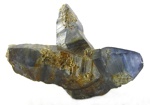Sapphire Info
Back to Sapphire
 |
| Sapphire Cluster Mogok / Myanmar * |
* Photo by kind permission of © www.irocks.com, Dr. Robert Lavinsky.
History
The name "sapphire" is derived from the Latin word "Sapphirus", and the Greek word "Sappheiros", both meaning "blue". The oldest sapphires were already found in ancient times in Sri Lanka. Since 800 BC sapphires have been regarded as gemstones. Blue sapphires were a holy stone to some religions, perhaps because of their color which reflexes the blue sky, and heaven.
Monarchs always wore blue sapphires as a defense from harm, and the British Crown Jewels show a lot of blue sapphires. Already King Solomon wore a sapphire ring, and in modern times, Prince Charles gave a sapphire engagement ring to Princess Diana. In history sapphire was often associated with the sacred and divine, guardian of innocence and bestower of truth. It should attract divine favor to its owner, protect travellers, ward off illness, bring peace, joy, wisdom and prosperity. In the 12th century, sapphire was the most appropriate stone for ecclesiastical rings. In the 18th century, sapphire was used to test female loyalty, changing its color if the woman was unfaithful.
The best sapphires came from Kashmir (the border region between India, Pakistan, and China). In 1881, they were dicovered by two Kashmiri hunters, after a hillside above the village of Sumjam slipped away, on an altitude of 16,000 feet. Afterwards Kashmiris could collect considerable quantities of fine large stones.
Formation and Resources
 |
| Sagyin Hills / Myanmar * |
 |
| Inn Gaung Mining Area / Myanmar * |
The mode of occurrence of sapphire is similar to the occurrence of ruby. Sapphires are found in sands and solid rocks, frequently together with ruby.
Valuable sapphires are found in Australia, Brazil, Cambodia, India, Kenya, Madagascar, Malawi, Myanmar, Nigeria, Sri Lanka, USA, Tanzania, Thailand, Vietnam, and Zimbabwe.
* Photo by kind permission of © www.ruby-sapphire.com, Richard W. Hughes.
Color
Besides the normal blue color, sapphires show a large amount of different colors ("fancy" colors): white, yellow, orange ("padparadja"), pink, purple, violet, and green.
The color of a sapphire is the most important quality criterium. An intense, rich, full blue color which still looks blue in artificial or daylight is the most wanted one. Depending on where sapphires are found, the color intensity varies very much. Connoisseurs regard the velvety "Kashmir color" as the most beautiful and valuable one: an intense blue with very subtle violet undertones, and a fine, silky shine.
Stars
Star Sapphires with a good color, and sapphires with an intense color change are also very much sought-after. Star sapphires show a silky transparency from included rutile needles. The light star appears on the surface of a sapphire cabochon. The star has usually six rays, sometimes twelve. If one moves the cabochon below a spotlight, the star wanders across the surface. The value of a star sapphire depends on its color, transparency, and the star itself: its rays should cover the whole surface, be narrow and sharp, and the star's center should be in the middle of the surface.
Quality and Value
The value depends on size, color, transparency, and origin. Besides the stones from Kashmir sapphires from Myanmar and Sri Lanka are also highly valued. Today guaranteed, untreated sapphires with a nice color are more and more sought-after. Top stones remain rare.
Inclusions (which still prove the genuineness of the stone) don't have a big influence on the value as long as they don't reduce the transparency or are visible through the top facet ("table").
The cut is also an important quality criterium. Only a perfect cut can emphasize the beauty of a gemstone. A bad cut always lowers the value.
⇐ Intro Page ⇐ Gemstones ⇐ Sapphire